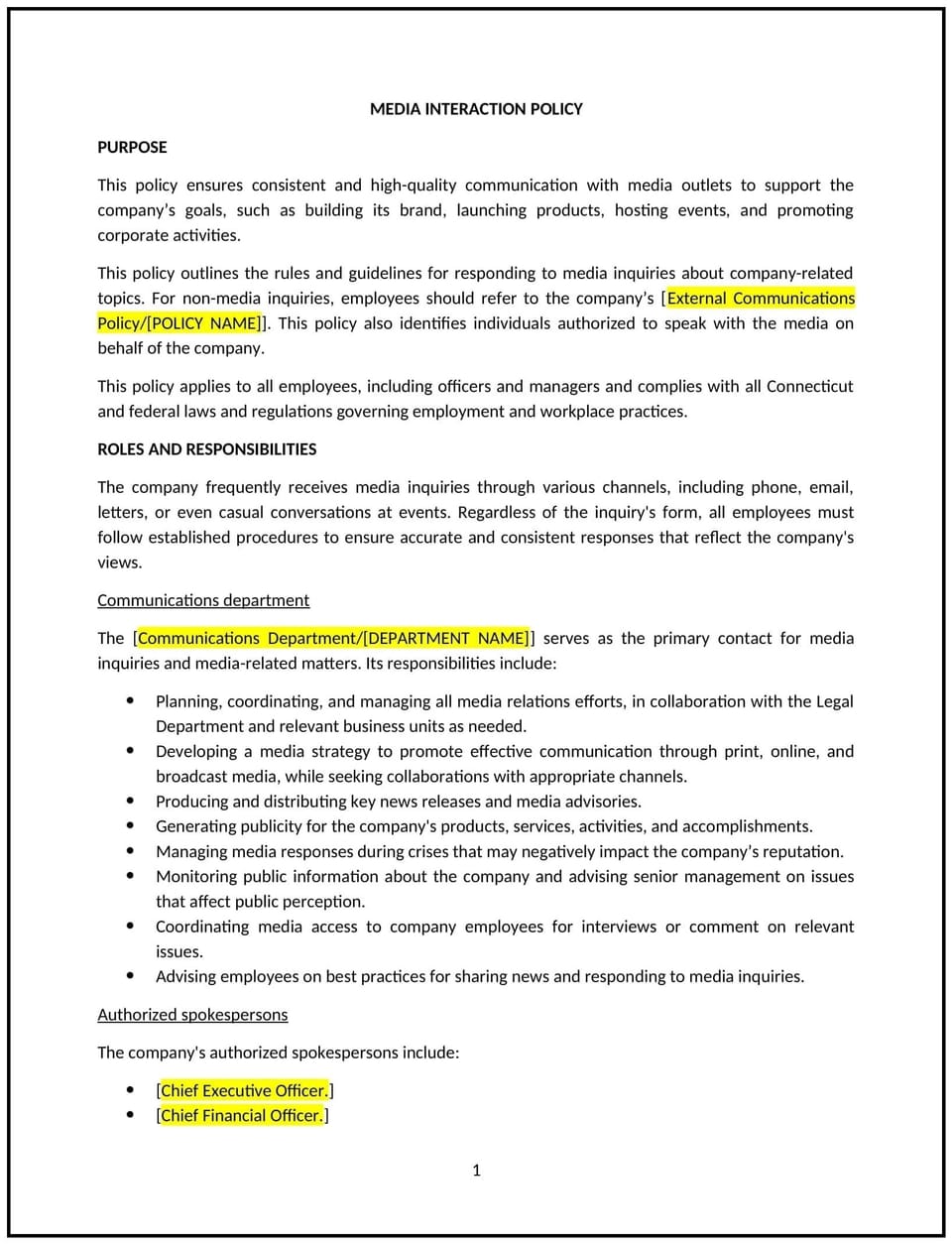Media relations policy (Connecticut): Free template

Media relations policy (Connecticut)
A media relations policy helps Connecticut businesses manage interactions with the media, ensuring that all public statements and communications are consistent, accurate, and in alignment with the company's objectives. This policy outlines who is authorized to speak on behalf of the company, the process for handling media inquiries, and how to manage the release of information to the public, while protecting the company’s reputation and complying with applicable laws.
By implementing this policy, businesses can control their public image, ensure effective communication with external stakeholders, and mitigate risks associated with inaccurate or misrepresented information.
How to use this media relations policy (Connecticut)
- Define authorized spokespersons: Clearly specify which individuals are authorized to speak to the media, including executives, communications professionals, or designated company representatives.
- Set guidelines for media interactions: Provide procedures for responding to media inquiries, including the need for approval of statements, press releases, or other public-facing communications.
- Establish messaging consistency: Ensure that all media communications align with the company’s core messaging and values, preventing mixed messages or contradictory statements.
- Handle sensitive information carefully: Define what types of information are considered confidential or proprietary, and provide guidance on what can and cannot be disclosed to the media.
- Plan for crisis communication: Establish a protocol for managing media relations during a crisis or negative event, including how to respond to media inquiries and mitigate damage to the company’s reputation.
- Monitor media coverage: Implement a system for tracking media coverage of the company to assess the effectiveness of the policy and adjust as needed.
Benefits of using this media relations policy (Connecticut)
This policy offers several benefits for Connecticut businesses:
- Protects the company’s reputation: By controlling media interactions and ensuring consistent messaging, businesses can protect their public image and reduce the risk of misrepresentation or damage.
- Enhances communication: Streamlines communication with the media and ensures that the company's messaging is clear, aligned with business goals, and effectively communicated to the public.
- Complies with legal requirements: Helps the business comply with state and federal regulations, including those related to the release of sensitive information, privacy, and intellectual property.
- Reduces risk of misinformation: By clearly defining who can speak on behalf of the company, the policy helps prevent unauthorized or misleading statements that could harm the business.
- Builds media relationships: A well-defined media relations policy helps foster strong, professional relationships with journalists and media outlets, which can be valuable for promoting the company in the future.
Tips for using this media relations policy (Connecticut)
- Communicate the policy clearly: Ensure that all employees, particularly those in management and communications, understand the guidelines for engaging with the media.
- Train authorized spokespersons: Provide media training to authorized spokespersons to help them effectively communicate with journalists and handle difficult questions or sensitive topics.
- Coordinate responses: Ensure that all media responses are coordinated and approved by the designated spokesperson to avoid conflicting statements.
- Monitor media coverage regularly: Track and analyze media coverage of the company to assess how the policy is being followed and identify areas for improvement.
- Review periodically: Regularly update the policy to reflect changes in company goals, media trends, or legal requirements to keep it relevant and effective.
Q: How does this policy benefit my business?
A: The policy ensures that all media interactions are consistent, accurate, and in alignment with the company’s values and messaging, protecting the company’s reputation, reducing risks of misinformation, and enhancing communication with stakeholders.
Q: Who is authorized to speak to the media on behalf of the company?
A: Only designated individuals, such as senior executives, communications managers, or PR representatives, are authorized to speak to the media. This ensures that all public statements are consistent with company policy and messaging.
Q: How can I handle media inquiries in a crisis situation?
A: The policy should outline a crisis communication protocol, including a designated spokesperson, approved messaging, and steps for handling negative press or inquiries. Timely, coordinated responses are key to mitigating potential damage.
Q: What types of information should be kept confidential in media interactions?
A: Confidential information may include proprietary business data, trade secrets, sensitive financial information, employee details, or anything that could harm the business if disclosed. Employees should be trained on how to recognize confidential information and handle it appropriately.
Q: How often should this policy be reviewed?
A: The policy should be reviewed annually or whenever there are changes in company strategy, media trends, or legal regulations to ensure it remains up-to-date and effective.
This article contains general legal information and does not contain legal advice. Cobrief is not a law firm or a substitute for an attorney or law firm. The law is complex and changes often. For legal advice, please ask a lawyer.


